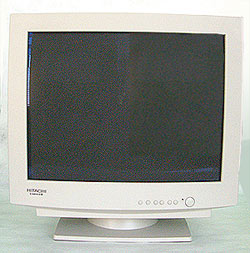Hitachi CM828 21 inch CRT Monitor Review
There can
often be a surprising difference in the level of picture quality between to
seemingly identical monitors. For instance, the Hitachi CM810 is a value-priced 21" display that for
all intensive purposes is just about identical to the CM828 we are looking at
now, at least from the outset.
Of course
the similarities are only bezel deep. The CM828 is higher-end display
that sports an even nicer display tube than the very economical CM810. That's not
to say the CM810 is not a good display, as it does have it's
fine points - you can read our review of the CM810 here
.
Now before we get too far off
topic, the Hitachi CM828 we are looking at today is a large screen 21"
display based on an Invar shadow mask and housed in a cabinet about the size of
what a 19" display would typically use. With the CM828 sitting next to my 19" ADI
E66 Microscan it's difficult to tell from the rear, which display should be the
larger one. Both units are about the same volume.
On a more down to earth level, the smaller cabinet
makes moving the display a bit easier, although it's still quite heavy at 27
kilos.
 |
Hitachi
CM828 CRT Display:
21" CRT, Invar
shadow mask, black matrix, short persistence phosphors, dark
tint
anti-reflective coat.
Dot pitch of
0.21mm. Horizontal mask pitch of
0.20mm.
2048 x 1536
max resolution
Dual 15-pin D-sub analog video
inputs.
Comes with: 6
foot power cord, 6
foot video cable, drivers, manual.
Weight: 27kg
Power Consumption: 115W
Manufacturer:
Hitachi Displays
Cost: ~$800
USD |
The CM828 is one of the growing class of 21" displays
that support multiple inputs. With two 15-pin analog connections on the rear
this display can be connected to two independent computers. An input select key
on the front of the monitor lets you switch from one video input display to
another with out having to restart either the display or the computers
involved.

The bezel is fairly clear of buttons, with the majority of features
accessible from the OSD. Still, there are a few key button on the front of the
display to make navigating through that OSD possible. In addition to the input
select key, and the menu key, there are left and right keys, a plus and negative
key (which also function as the direct contrast / brightness keys) a monitor
status LED and a nice big power button.


